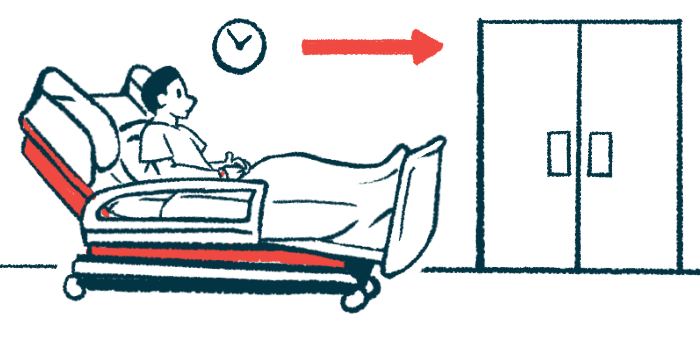Cortisol, ACTH levels after pituitary surgery predict Cushing’s remission
Real-world study also shows higher remission rates after 1st vs. 2nd surgery
Written by |

Blood levels of cortisol or adrenocorticotropic hormone (ACTH) measured one day after pituitary tumor removal surgery independently predicted Cushing’s disease remission after one year, according to a real-world study.
Post-surgical remission rates were higher among adults after a first surgery compared with those seen for patients who underwent a second surgery following disease recurrence. Pediatric patients younger than age 18 also were found to have lower remission rates compared with adults.
Findings from the real-world study were detailed in a report titled “Clinico-radiological parameters, biochemical and molecular alterations predicting remission and recurrence after surgical treatment of corticotroph adenomas – Cushing’s disease,” published in the journal World Neurosurgery.
Seeking to ID clinical factors to predict Cushing’s disease remission
Cushing’s disease is usually caused by a non-cancerous tumor in the pituitary gland, a pea-sized structure located near the bottom of the brain. Such tumors produce and release excessive amounts of ACTH — a molecule that signals the adrenal glands above the kidneys to produce cortisol. High levels of cortisol ultimately cause Cushing’s symptoms.
Transsphenoidal adenomectomy, a surgical procedure used to remove the disease-driving tumor in the pituitary gland, is the first-line treatment for Cushing’s disease. This type of surgery can be performed with the aid of an endoscope — a thin, lighted tube with a small camera — or a microscope.
While most patients achieve remission, or show no signs of disease activity, after surgery, others may not respond and require a second surgery or other supportive treatments.
With that in mind, researchers in India set out to identify clinical factors that predict Cushing’s disease recurrence after surgery.
“This would help us in the prognostication [outcome prediction] of these patients, and to compare outcomes of these surgeries across centers,” the researchers wrote.
To that end, the team analyzed data from more than 100 Cushing’s disease patients who had surgery at their institute from January 2009 to September 2022.
Among the 174 surgeries performed during that time, 140 were primary procedures, 22 were secondary surgeries that had been carried out due to disease recurrence, and 24 were conducted on pediatric patients younger than 18. Another 12 surgeries involved patients with Nelson’s syndrome — a condition caused by the removal of both adrenal glands in which pituitary tumors continue to grow and release high levels of ACTH.
Remission rate after pituitary surgery lower for pediatric patients
The remission rate after one year among patients who underwent primary surgery was 75%, and among those who underwent a second surgery, it was 47.4%. In pediatric patients, the remission rate was 55.5%, while in Nelson’s syndrome it was 50%.
“The remission rates in both [the] revision [secondary] surgery and Nelson’s syndrome cohort were significantly lower than the primary surgery cohort,” the researchers wrote.
One day after primary surgery, cortisol levels below 11.1 micrograms per deciliter of blood (mcg/dL) significantly correlated with Cushing’s remission at one year. Likewise, after secondary surgery, day one cortisol levels below 6.83 mcg/dL predicted remission, while cortisol levels below 8 mcg/dL were indicators of disease remission among pediatric patients. Post-operative cortisol levels were not correlated with these outcomes in Nelson’s syndrome patients.
Similarly, low levels of ATCH one day after surgery predicted Cushing’s remission in the primary group (below 18.35 mcg/dL) and pediatric patients (below 19.35 mcg/dL). No predictive correlations were found for ATCH levels measured one day after secondary surgery and disease remission among patients with Nelson’s syndrome.
Post-operative day 1 plasma cortisol, ACTH levels are strong independent predictors of remission in the primary [first] surgery cohort. … The remission rate in pediatric patients is lower as compared to adults for reasons unknown and this requires further studies.
Additional analyses revealed that patients who had the highest chance of remission were those who underwent endoscopic surgery and in whom tumors had been identified upon tissue analysis.
In line with these findings, remission rates seen after primary endoscopic surgery were found to be significantly higher compared with those seen after microscopic surgery (81.08% vs. 57.14%). In fact, patients who underwent microscopic surgery without showing any signs of a tumor were more than 30 times less likely to achieve remission compared with those who underwent endoscopic surgery and in whom a tumor had been identified on tissue analyses.
“Post-operative day 1 plasma cortisol, ACTH levels are strong independent predictors of remission in the primary [first] surgery cohort,” the researchers wrote. “The remission rate in pediatric patients is lower as compared to adults for reasons unknown and this requires further studies.”







